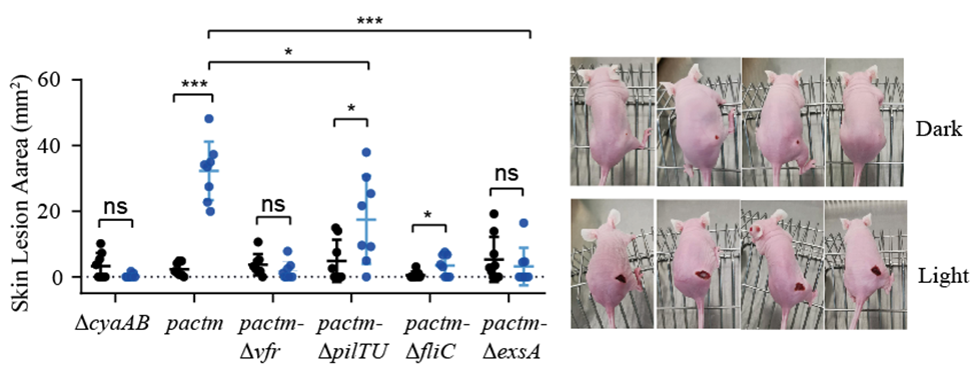Researchers Developed an Engineered P. Aeruginosa Strain to Realize the Optical Control of the Movement Behavior of the Bacteria
Date:23-03-2021 | 【Print】 【close】
Recently, Jin Fan' s group at the Shenzhen Institute of Advanced Technology (SIAT) of the Chinese Academy of Sciences, Liu Zhi’s group at Huazhong University of Science and Technology collaborated to design an engineered strain based on Pseudomonas aeruginosa, which realized the optical control of the movement behavior of the bacteria and its infection on the host. The results of this study were published in the international academic journal ACS Synthetic Biology under the title of "Optogenetic Modification of Pseudomonas aeruginosa Enables Twitching Motility and Host Infection" .
Cyclic adenosine monophosphate (cAMP) is an important secondary messenger that controls carbon metabolism, type IVa pili (TEP) biogenesis, and virulence in Pseudomonas aeruginosa. When cAMP regulates a certain physiological function in bacteria, it usually simultaneously regulates the expression levels of multiple component proteins that affect this physiological function. For example, the cAMP–Vfr complex control TEP biogenesis by collectively regulating the expression level of the TEP structural protein PilA, motor protein PilT, PilB and transcriptional regulatory protein PilR together. Therefore manipulation of intracellular cAMP level is sufficient to control bacterial twitching activity. Similarly, cAMP-Vfr also control the expression of the type III secretion system genes through the master regulator ExsA and control the expression of the exotoxin ToxA directly through transcription. Usually, Changes in bacterial physiological functions, such as twitching motility and virulence, are usually not easily accomplished by controlling the expression of a single or small number of genes.

Figure 1. Design principle and application diagram of the engineered strain pactm. (Image by SIAT)
Based on the above understanding, Jin Fan's research group developed an engineered P. aeruginosa strain (named pactm) with light-dependent intracellular cAMP levels by introducing a photoactivated adenylate cyclase gene (bPAC) into bacteria. The engineered strain can reversibly change its ability of twitching motility and host infection in response to illumination of blue light. Under the illumination of blue light, the expression of cAMP response promoter in pactm was increased 15-fold, and the ability of twitching motility was increased 8-fold. The subcutaneous infection model of nude mice showed that the skin lesion area caused by pactm infection was increased 14-fold. Therefore, this work provides a solution for the construction of a controlled infection experimental model. In addition, the author also successfully guided the expansion direction of the bacterial population through the design of macroscopic illumination mode, which provided convenience for the study of the contact-dependent interactions between microorganisms.

Figure 2. Control infection ability of pactm to mice using blue light. (Image by SIAT)
Media Contact:
SUN Lujia
Email: lj.sun@siat.ac.cn
Download the attachment:
Optogenetic Modification of Pseudomonas aeruginosa Enables Twitching Motility and Host Infection